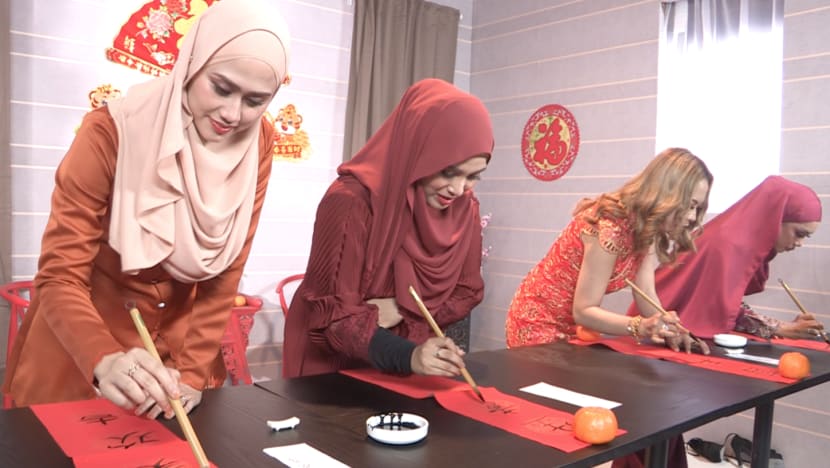Sing it in Bahasa Melayu: Chinese New Year song celebrating cross-cultural unity warms Malaysians’ hearts

The artistes and performers in the music video of Dong Dong Qiang, a Chinese New Year song in the national language of Malaysia. (Photo courtesy of MVM Production)
KUALA LUMPUR: This is not your typical Chinese New Year song.
It ticks all the necessary boxes - upbeat tunes, positive lyrics and costumes in auspicious colours - but Dong Dong Qiang, released on Jan 7, stands out with its all-Malay ensemble singing in Bahasa Melayu.
This is likely the very first original Chinese New Year song in the national language of Malaysia, according to its music producer and composer Nevin Hiong, and one that has united Malaysians in applauding the unique efforts.
With customary “gong xi gong xi” and “dong dong qiang” interwoven with Malay lyrics, the song features Ayie Floor 88, Harry Khalifah, Sarah Suhairi, Beby Acha, Lia Aziz and Aidilia Hilda.
“When the owner of record label MVM Production reached out to me to produce a Chinese New Year song for his Malay artistes, he didn’t specify that it should be in Bahasa Melayu.
“He only set three requirements - the song should contain ‘gong xi ni’, ‘dong dong qiang’ and ‘huat ah’, phrases that Malay friends are familiar with,” Hiong told CNA.
The phrases, respectively, are a common Chinese New Year greeting, an onomatopoeia for drum beat and cymbal clash, and Hokkien for prosperity.
“I was thinking, these three phrases are Chinese and the song will be performed by Malay artistes, why not incorporate Malay-style melody and Chinese instruments for something special?” Hiong added.

The catchy tunes were then paired with lyrics penned by Hiong’s production manager, who is known as Uncle Chain. The song quickly captured the hearts of Malaysians after it was uploaded on Youtube, with many praising it for portraying the harmonious interracial ties in the country.
“Our original intention was to produce a Chinese New Year song, but now it has evolved into a patriotic song,” Hiong said of the unexpected responses.
UNINTENDED RACIAL UNITY MESSAGE
In the music video, red lanterns and plum blossoms adorn the sets as the artistes try their hand at Chinese calligraphy and playing a lion dance troupe’s drum.
Donned in Chinese and Malay traditional attire, they belt out: “We appear different on the outside, but our hearts are the same. We are like a tree with strong roots.”
At one point, the Chinese instruments give way to Malay drums and Ayie shows off his zapin (traditional Malay dance) moves.
Even some members of the lion dance troupe featured in the song are Malays, Hiong revealed.
Every scene painted a picture of cross-cultural experience, but Hiong said there was no deliberate intention on their part to promote racial harmony.
Rather, “it was mostly about having fun with ideas”, a natural product of a team of Chinese and Malay creatives who are used to working with each other.
“Malays have a great sense of humour. They live modestly and are easily satisfied. They are happy-go-lucky. And they tend to have fun while at work, so it’s enjoyable working with them,” Hiong, an award-winning filmmaker and director, said.
“They are also highly talented artistically. If the scenes require them to cry, their tears will immediately fall,” he added.
For Sarah, one of the celebrities in Dong Dong Qiang, her Chinese colleagues’ time management skills is among the things she appreciates.
“They want everything to be perfect but at the same time, they are not very strict. They allow us to enjoy ourselves while doing the project,” she told CNA.

WITH LEARNING COMES UNDERSTANDING
Dwelling deeper into Chinese culture and learning a little bit more about fellow Malaysians during the song production proved to be a fruitful experience for the artistes too.
Sarah said: “I have never tried singing in another language, let alone singing a festive song about another culture.”
While “gong xi” is an ubiquitous new year greeting seen on banners and billboards as Chinese New Year nears, getting the pronunciation right was a challenge for her.
“It’s not ‘gong’ or ‘kong’ but ‘gung’.
“It’s very hard for us to get the exact sound and pronounce it right from the start. We had a lot of struggles but we really enjoyed the song,” she said.

Showing the piece of Chinese calligraphy she wrote on the set, Sarah recalled how they were taught the right way of holding the brush and dipping it into the ink.
The phrase assigned to her was “shen ti jian kang (good health)” and she made sure she brought her work home as a keepsake.
Dong Dong Qiang has so far raked in more than 500,000 views on YouTube, and Hiong said he has received requests from local Chinese radio stations to play the song on air.
The record label has also been approached for performance engagements, Sarah added.
For the Year of the Tiger, she hoped Malaysians would appreciate the different cultures in the country.
“I hope everyone can be understanding about each other’s culture and not just find fault with other people. I am hoping that this year will be the year we learn something from others,” she said.
Read this story in Bahasa Melayu here.
















